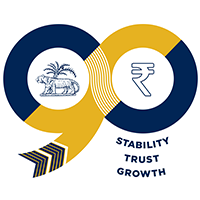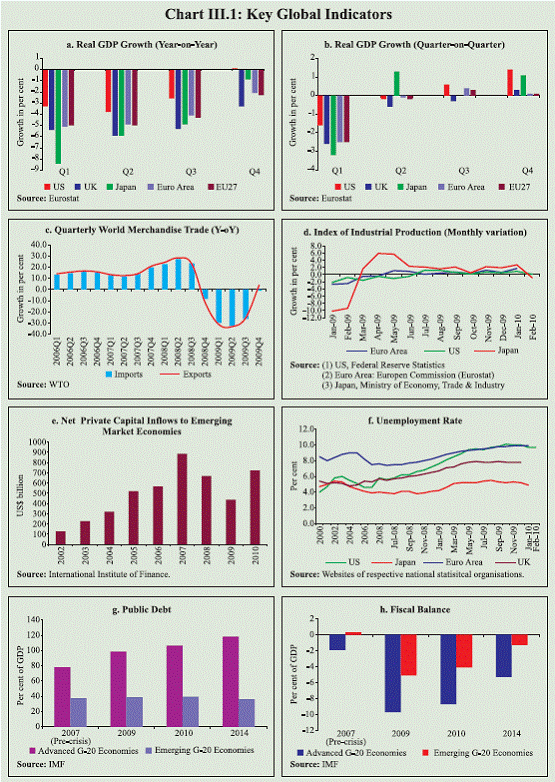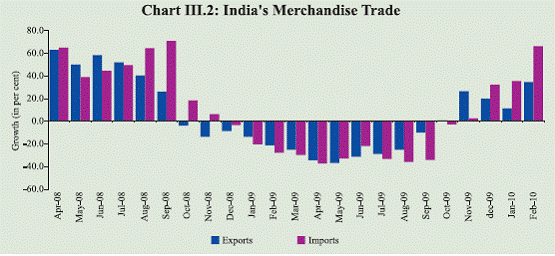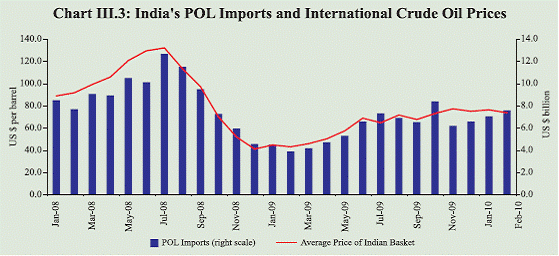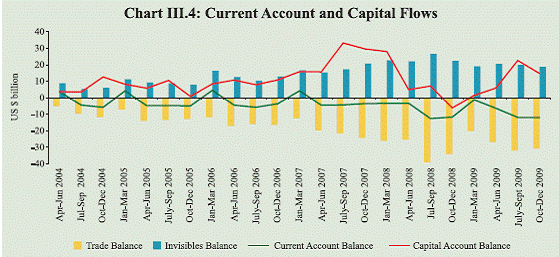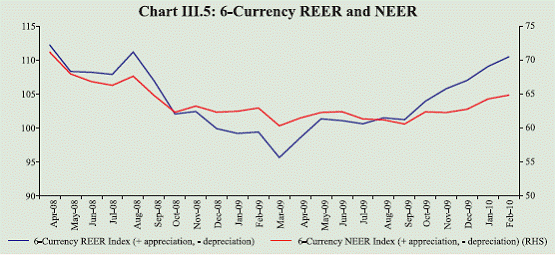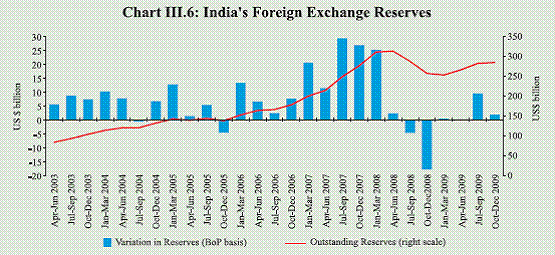III. The External Economy - RBI - Reserve Bank of India
III. The External Economy
India’s external sector witnessed further improvement with the recovery seen in the global economy as reflected in the turnaround in exports, buoyancy in capital inflows and further accretion to the country’s foreign exchange reserves. Exports recovered from 12 months of consecutive decline and posted an average growth of 20.5 per cent during November 2009-February 2010. Imports also turned around and exhibited an average growth of about 43.0 per cent during December 2009-February 2010, mirroring the impact of strong recovery in growth. India’s balance of payments position during April-December 2009 remained comfortable with a modest increase in current account deficit, despite a lower trade deficit, on account of decline in invisibles surplus. There has been a turnaround in capital inflows, mainly led by portfolio inflows, reflecting the buoyant growth prospects of the Indian economy. India’s foreign exchange reserves during 2009-10 increased by US$ 27.1 billion to reach US$ 279.1 billion as at end-March 2010. As on April 9, 2010, foreign exchange reserves stood at US$ 280.0 billion. III.1 Reflecting the improving global conditions, India’s merchandise exports have recovered since October 2009, after a phase of twelve consecutive months of decline. Imports have also shown a strong turnaround since December 2009, driven by the stronger recovery in growth. The balance of payments (BoP) position during April-December 2009 remained comfortable. International Developments III.2 The international economic situation improved further with most economies exhibiting acceleration in recovery during the fourth quarter of 2009 on the back of revival in world trade and industrial production. Since the decline in industrial production and exports had been sharper than in output during the global recession, recovery in industrial production and exports has also been stronger than in output. Global recovery, however, now seems to be multi-paced, led by the EMEs and self-sustaining recovery is yet to take hold. III.3 Signs of recovery were particularly firm in the fourth quarter data of various economies (Chart III.1 a and b). Asia continues to spearhead the global recovery. Going forward, both advanced and emerging market economies are expected to exhibit stronger recovery in 2010, though the speed would remain divergent across the countries (Table III.1). Stronger economic frameworks and rapid policy responses have helped many emerging economies to mitigate the impact of the unprecedented external shocks. III.4 After a period of decline in world trade over four consecutive quarters, growth in world trade has turned around (Chart III.1 c). According to the latest monthly data from the IMF (International Financial Statistics), world exports showed a positive growth of 19.1 per cent in January 2010. This was in line with the rise in world commodity prices. As per the WTO data, the world merchandise exports increased by 10.3 per cent (sequential quarter-onquarter) in the fourth quarter of 2009, though on a year-on-year basis, the increase was lower at 3.9 per cent.
III.5 The recovery in advanced economies was also evident in the growth of industrial production (month over month) (Chart III.1 d). With stronger recovery in EMEs and given the easy global liquidity conditions, capital inflows to EMEs have been projected to revive in 2010, though may remain much below the high level reached in the pre-global crisis period (Chart III.1 e). The persisting high unemployment has brought to the fore the risk of jobless recovery, which would influence country strategies on exit (Chart III.1 f). Post-stimulus high levels of public debt in advanced economies and the challenges of recovering to pre-crisis levels would remain a permanent concern for the global economy in the post-crisis period (Chart III.1 g and h). III.6 On the way forward, there are significant risks to the global growth outlook. On the downside, a key risk emanates from differential growth and inflation conditions across countries leading to asymmetry in the timing of exit from crisis-time supportive policies, which may negatively impact global growth pattern and its rebalancing, besides influencing exchange rate and asset prices in EMEs through shifts in the pattern of capital flows. The impaired financial systems/housing markets and rising unemployment in key advanced economies may hold back the recovery in household spending. Another key risk to global growth
III.7 The impact of the recovery in the global economy on India’s external sector was visible in the turnaround in exports and continuation of capital inflows. Despite concerns about protectionism as a response to the global crisis, the recovery in world trade projected for 2010 would improve the export prospects for India. Easy global liquidity conditions and higher growth prospects of India could add momentum to the revival in capital flows seen so far. The de-coupling of recovery across countries and the increasing divergence of inflationary conditions were also reflected in India. This suggests that while global developments continue to impact India, there is greater evidence of asymmetry, both in terms of the pace of recovery and the headline inflation. Merchandise Trade Exports III.8 Trade channel of the contagion from the global crisis had affected India’s export performance, which declined over twelve consecutive months. Since October 2009, export growth has turned around (Chart III.2). Export growth averaged at 20.5 per cent during November 2009 to February 2010. The increase in exports has coincided with the uptrend in world commodity prices as well as the recovery in the global economy. Cumulatively, exports during 2009-10 (April-February) registered a decline of 11.4 per cent as against a growth of 18.2 per cent a year ago.
III.9 Commodity-wise exports data for the period 2009-10 (April-September) revealed that manufactured goods continued to maintain their largest share (69.4 per cent), followed by petroleum and primary products. Moreover, during the period, the share of manufactured goods increased along with decline in the shares of petroleum and primary products. During April-September 2009, the exports of all major commodity groups declined (Table III.2). III.10 Destination-wise, developing countries and OECD countries were the major markets for India’s exports, accounting for 37.9 per cent and 36.6 per cent shares, respectively. Another major destination was OPEC with 23.3 per cent share. Country-wise, the UAE (with a share of 14.1 per cent) was the largest destination for India’s total exports followed by the US, China, Singapore, Hong Kong and the UK. Exports to all major export destinations declined during the period.
Imports III.11 India’s imports, after declining since December 2008 for eleven months, exhibited reversal in trend in November 2009 with an increase of 2.6 per cent. The uptrend in imports continued through February 2010. Between December 2009 and February 2010, import growth averaged at 43.0 per cent. Cumulatively, during 2009-10 (April-February), imports recorded a decline of 13.5 per cent in contrast with a growth of 25.9 per cent a year ago, which resulted from lower international crude oil prices during the period and slowdown in domestic economic activity. Reflecting the increase in oil prices and the higher volume of oil imports on account of the economic recovery, oil imports have increased during the recent period (Chart III.3).
III.12 The commodity-wise imports during April-September 2009 indicated slowdown in non-POL imports, which was mainly due to sharp decline in imports of capital goods, gold and silver, pearls, precious and semi-precious stones, chemicals, iron and steel. Imports of edible oil and pulses, however, witnessed considerable growth, reflecting domestic supply constraints and higher prices (Table III.3).
III.13 Source-wise, during April-September 2009, developing countries had the highest share in India’s imports (33.6 per cent), followed by OECD (32.7 per cent) and OPEC (30.7 per cent). Country-wise, China continued to be the single largest source of imports with a share of 12.0 per cent in India’s total imports, followed by the US, the UAE, Saudi Arabia, Australia and Iran. III.14 Merchandise trade deficit during 2009-10 (April-February) stood at US$ 95.7 billion, which was lower by 16.6 per cent than the level during 2008-09 (April- February), reflecting relatively larger decline in imports than exports (Table III.4). Balance of Payments (BoP) Current Account III.15 The impact of global economic recovery was visible in different accounts of India’s balance of payments. The current account position during the third quarter of 2009-10 witnessed a turnaround in both exports and imports. India’s merchandise exports (on BoP basis) registered a robust growth in the third quarter of 2009-10 as compared with decline in the corresponding period of 2008-09. Imports (on BoP basis) increased moderately during the quarter as compared with a higher growth in the corresponding quarter of the previous year. Trade deficit was lower during the third quarter of 2009-10 as compared with the preceding quarter and the corresponding quarter a year ago. During April-December 2009 also, trade deficit remained lower (US $ 89.5 billion) as compared with the corresponding period of the preceding year (US$ 98.4 billion) led by decline in both oil and non-oil imports (Table III.5). Invisibles III.16 The robust growth observed in invisibles receipts and payments in the past few years was reversed during 2009-10, reflecting the lagged impact of the recession in advanced economies. The decline was seen in both factor and non-factor components. Although software exports witnessed a turnaround, the decline in nonsoftware exports mirroring the impact of global economic slowdown resulted in a decline in the overall services exports during the quarter. The decline in investment income receipts during the quarter was mainly on account of continued lower interest rates in advanced economies. Private transfer receipts, however, remained strong during the quarter. Invisibles payments registered a higher growth during the quarter as compared with the corresponding period of 2008-09. Overall, the net invisibles (i.e., invisibles receipts minus invisibles payments) were lower during the quarter as compared with the corresponding period of the previous year (Table III.6).
III.17 During April-December 2009, invisibles receipts (except private transfer receipts) registered a decline, while invisibles payments witnessed a marginal increase over the corresponding period of the previous year. Net services exports of India declined by 36.9 per cent during April-December 2009 as against an increase of 30.9 per cent during the corresponding period of last year, mainly due to significant decline in services receipts coupled with increase in services payments. While the decline in services receipts was due to decline in almost all the components of services, the increase in services payments was mainly driven by business and financial services. Consequently, net invisibles stood lower during April-December 2009 as compared with the corresponding period of the previous year. At this level, the invisibles surplus financed 66.1 per cent of trade deficit during April-December 2009 as against 72.1 per cent during April-December 2008. Despite lower trade deficit, the fall in invisibles surplus led to marginally higher current account deficit during the third quarter of 2009-10 (Chart III.4). The current account deficit during April-December 2009 stood at US$ 30.3 billion, higher than US$ 27.5 billion during April-December 2008. During 2008-09, current account deficit as a per cent of GDP stood higher at 2.4 per cent as compared to 1.3 per cent a year ago.
Capital Account III.18 Capital flows continued to remain buoyant during the third quarter of 2009- 10, mainly led by large inflows under foreign direct investments, portfolio investments and short-term trade credits (Chart III.4 and Table III.7). III.19 The latest available information on certain indicators of the capital account indicates that the revival in capital inflows, which started at the beginning of 2009-10 and gathered momentum in the second and third quarters, has remained buoyant even in the last quarter (Table III.8). Stronger recovery in 2009-10 ahead of the global economy coupled with positive sentiments of global investors about India’s growth prospects are the factors that underlie the momentum of sustained capital inflows during the year.
III.20 Going forward, capital inflows to India during 2010-11 are expected to be stronger driven by both push and pull factors. While the push factors for surge in capital inflows include excess global liquidity accompanied by low interest rates leading to search for higher yield, the pull factors include the buoyant growth prospects, favourable interest rate differential and relaxation of ECB norms for 3G spectrum. Higher expected capital inflows, however, may exert pressures on asset prices and exchange rate. III.21 The appreciation of the rupee against the US dollar and increase in inflation differentials between India and its trading partners during the year led to appreciation of the real exchange rate (Chart III.5 and Table III.9).
Foreign Exchange Reserves III.22 On balance of payments basis (i.e., excluding valuation effects), the foreign exchange reserves increased by US$ 11.3 billion during April-December 2009 as against a decline of US$ 20.4 billion during April-December 2008. The valuation gain, reflecting the depreciation of the US dollar against the major international currencies, accounted for US$ 20.2 billion during April-December 2009 as compared with a valuation loss of US$ 33.4 billion during April-December 2008. Accordingly, valuation gain during April-December 2009 accounts for 64.1 per cent of the total gross increase in foreign exchange reserves.
III.23 During 2009-10, India’s foreign exchange reserves increased by US$ 27.1 billion to reach US$ 279.1 billion as at end- March 2010 (Table III.10 and Chart III.6). Foreign currency assets (FCAs) increased by US$ 13.3 billion during the year. Furthermore, the Reserve Bank purchased 200 metric tonnes of gold from the IMF on November 3, 2009 as part of the Reserve Bank’s foreign exchange reserve management operations. The foreign exchange reserves, however, remained unaffected by this transaction as it merely reflected substitution of foreign currency assets by gold. The IMF made additional allocations of SDRs to India in two tranches, viz., general allocation of SDR 3,082 million (equivalent to US$ 4.82 billion) on August 28, 2009 and a special allocation of SDR 214.6 million (equivalent to US$ 0.34 billion) on September 9, 2009. Foreign exchange reserves stood at US$ 280.0 billion as on April 9, 2010.
External Debt III.24 India’s external debt stock at US$ 251.4 billion at end-December 2009 recorded an increase of US$ 26.8 billion over its level at end-March 2009, mainly on account of increase in long-term debt (Table III.11). Both long-term and shortterm debt increased at end-December 2009 from their levels at end-March 2009. Of the total increase in India’s external debt at end-December 2009, the valuation effect on account of depreciation of US dollar against major international currencies accounted for 36.9 per cent.
III.25The ratio of short-term to total debt declined at end-December 2009 from its level at end-March 2009. Similarly, the ratio of short-term debt to foreign exchange reserves moderated during the period. In terms of currency composition, the US dollar denominated debt accounted for the major portion of total external debt at end-December 2009. International Investment Position III.26 India’s net international liabilities were placed at US$ 117.1 billion at end-December 2009 as compared with US$ 96.0 billion at end-September 2009. The international assets increased from US$ 378.9 billion at end-September 2009 to US$ 385.9 billion at end-December 2009, mainly on account of increase in direct investment abroad, reserve assets, and other investment during the quarter. The increase in international liabilities from US$ 474.8 billion to US$ 503.0 billion during the same period was on account of an increase in inward direct investment and portfolio equity investment (Chart III.7).
III.27 India’s external sector, thus, improved alongside the recovery in global economy and further stabilisation in global financial conditions. This was reflected in the turnaround in exports and continued buoyancy in capital inflows. Despite higher net capital inflows during 2009-10, reflecting improved absorptive capacity of the economy, capital inflows mostly financed the higher current account deficit. Reflecting easy global liquidity conditions and both interest rate and growth differentials in favour of India, capital inflows are expected to be strong, which may put pressure on asset prices and exchange rate. Global commodity price trends, particularly possible firming up of oil prices could exert pressures on the balance of payments through higher imports. For dealing with the external shocks transmitting through various accounts of the balance of payments, it is important to have adequate foreign exchange reserves. |
|||||||||||||||||||||||||||||||||||||||||||||||||||||||||||||||||||||||||||||||||||||||||||||||||||||||||||||||||||||||||||||||||||||||||||||||||||||||||||||||||||||||||||||||||||||||||||||||||||||||||||||||||||||||||||||||||||||||||||||||||||||||||||||||||||||||||||||||||||||||||||||||||||||||||||||||||||||||||||||||||||||||||||||||||||||||||||||||||||||||||||||||||||||||||||||||||||||||||||||||||||||||||||||||||||||||||||||||||||||||||||||||||||||||||||||||||||||||||||||||||||||||||||||||||||||||||||||||||||||||||||||||||||||||||||||||||||||||||||||||||||||||||||||||||||||||||||||||||||||||||||||||||||||||||||||||||||||||||||||||||||||||||||||||||||||||||||||||||||||||||||||||||||||||||||||||||||||||||||||||||||||||||||||||||||||||||||||||||||||||||||||||||||||||||||||||||||||||||||||||||||||||||||||||||||||||||||||||||||||||||||||||||||||||||||||||||||||||||||||||||||||||||||||||||||||||||||||||||||||||||||||||||||||||||||||||||||||||||||||||||||||||||||||||||||||||||||||||||||||||




